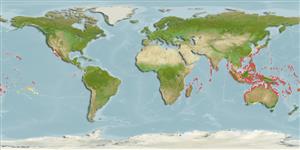Environment: milieu / climate zone / depth range / distribution range
Ecologia
marinhas associadas(os) a recifes; intervalo de profundidade 8 - 20 m (Ref. 9710). Tropical; 35°N - 35°S
Indo-Pacific: East Africa to Samoa, north to southern Japan, south to New South Wales and Tonga.
Tamanho / Peso / Idade
Maturity: Lm ? range ? - ? cm
Max length : 13.0 cm SL macho/indeterminado; (Ref. 48637)
Espinhos dorsais (total) : 1 - 2; Raios dorsais (total) : 29 - 34; Espinhos anais: 0; Raios anais : 26 - 30. Body and head color variable. Blackish to dark bluish branchial blotch extending dorsally to level well above the lower margin of eye and may include ventrally the pectoral fin base and axil. Iris usually dark brown. Orange to red caudal fin soft dorsal and anal fins clear, orange or yellow with spots; pectorals clear. Scale spinulation at midbody closely packed. Male scale ridge rugosities develop at about 80 mm SL developed. Strong first dorsal spine. Large pelvic fin rudiment narrowly attached to posterior margin of ventral flap.
Occurs in shallow lagoons and seaward reefs to a depth of about 15 m; common in coral-rich areas. Secretive species (Ref. 9710, 48637) among rocks, sponges or in crevices on the bases of large coral formations. Adults usually form pairs but often only one is observed while the other one is hiding (Ref. 48637).
Ciclo de vida ou comportamento de acasalamento
Maturidade | Reprodução | Desova | Ovos | Fecundidade | Larvas
Hutchins, J.B., 1986. Review of the monacanthid fish genus Pervagor, with descriptions of two new species. Indo-Pac. Fish. (12):35 p. (Ref. 527)
Status na Lista Vermelha da UICN (Ref. 130435: Version 2024-1)
Ameaça para os humanos
Harmless
Uso pelos humanos
Ferramentas
Relatórios especiais
Baixar XML
Fontes da internet
Estimates based on models
Preferred temperature (Ref.
123201): 23.7 - 29.2, mean 28.1 °C (based on 2532 cells).
Índice de diversidade filogenética (Ref.
82804): PD
50 = 0.5039 [Uniqueness, from 0.5 = low to 2.0 = high].
Bayesian length-weight: a=0.01995 (0.01135 - 0.03508), b=2.93 (2.77 - 3.09), in cm total length, based on LWR estimates for this species & (Sub)family-body (Ref.
93245).
Nível Trófico (Ref.
69278): 2.9 ±0.4 se; based on size and trophs of closest relatives
Resiliência (Ref.
120179): Elevada, tempo mínimo de duplicação da população menor que 15 meses (Preliminary K or Fecundity.).
Fishing Vulnerability (Ref.
59153): Low vulnerability (10 of 100).
Nutrients (Ref.
124155): Calcium = 77.8 [33.2, 197.0] mg/100g; Iron = 0.798 [0.360, 1.897] mg/100g; Protein = 17.9 [15.6, 20.1] %; Omega3 = 0.105 [0.049, 0.217] g/100g; Selenium = 25.1 [11.9, 58.5] μg/100g; VitaminA = 80.3 [22.1, 293.9] μg/100g; Zinc = 1.66 [1.06, 2.64] mg/100g (wet weight);
